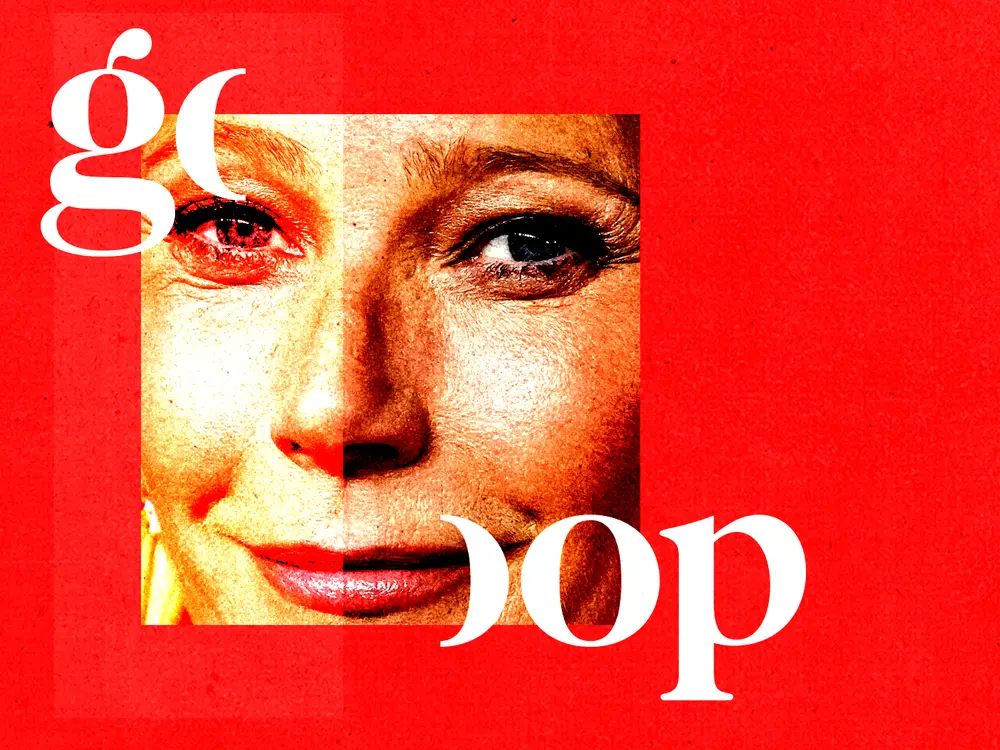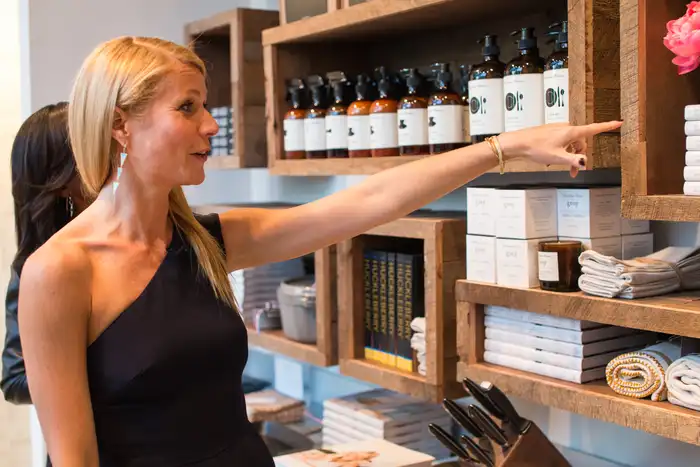How Gwyneth Paltrow’s Goop lost its glow

Gwyneth Paltrow took a measured tone earlier this year when she discussed Goop, her newsletter turned e-commerce company, onstage at a Forbes event. She didn’t brag about the nine figures the brand had raised or its latest product release. Instead, she said she was proud Goop was still in business.
“Some years we’re down, then we’re back up,” she said. “I’m proud that we’re still alive and kicking.”
That might seem surprising for a company that was valued at $433 million in 2020 and was a trailblazer for what a celebrity brand could be. But it’s reflective of a company that — despite its name recognition and pop-culture footprint — has undergone several painful pivots in recent years.
In September, Goop laid off nearly 20% of its staff, including its chief technology officer and its vice president of content. A few weeks later, it laid off about 6% of the remaining employees.
Goop’s recent cuts come as the company shifts focus to its beauty, fashion, and food businesses. It’s the latest in a series of strategy changes over the past several years.
Changes in focus are normal for a startup. Still, after 16 years of existence, the company isn’t profitable and continues to struggle to build a firm foundation apart from Paltrow.
The company’s once buzzy supplement regimens generated $100,000 in sales on the day they launched in 2017. Now, only one of the four initial regimens is still offered online, and for a discount. A Goop spokesperson told B-17 that any new supplements it launched would be part of its beauty business.

Goop, founded by Gwyneth Paltrow, has expanded into numerous verticals over the past decade-plus.
Julia Hunter, a Goop board member and the former CEO of Jenni Kayne, addressed some of the company’s struggles in an interview with Puck, published after B-17 sent Goop a series of questions for this story.
“The company is doing very well from a revenue perspective, but
operating expenses have continued to grow,” Hunter said. “I know that it’s unpopular to let people go, but they hired a lot of people that they probably shouldn’t have.”
On the content side, Goop has recently cut many editorial positions, including the vice president of content, the head beauty editor, and several other editors. A review of Goop’s website shows few new articles, and its book imprint hasn’t published a new release in over a year. The magazine ran two issues before folding, and while there were reports that Goop’s Netflix series, “The Goop Lab,” was renewed, it hasn’t materialized.
Paltrow’s importance to the brand is evident in product launches, two former Goop employees told B-17. They spoke on the condition of anonymity for fear of retaliation; their identities are known to B-17.
When she’s part of a launch campaign, Goop calls it an “A launch,” and the performance of the advertising on social media “quadruples,” one of the former employees said. Performance often drops off once she’s no longer involved, this person added.
Last month, a video featuring Paltrow that promoted Goop’s newest release, a retinol serum, drew 1,100 likes on Instagram. The next day, a second post about the serum — which didn’t include Paltrow — got fewer than 275 likes.
“Brands need to find viable business models, rather than simply a celebrity face,” Simeon Siegel, an analyst at BMO Capital, said of A-list entrepreneurs.
The celebrity brands that have grown to be the largest — like Kim Kardashian’s Skims, Rihanna’s Fenty, and Selena Gomez’s Rare Beauty — have moved beyond their founder’s image. Skims, which is valued at $4 billion, has made using models from popular culture a core part of its marketing strategy, for instance.
From newsletter to e-commerce shop: over a decade of pivoting
Goop’s founding story has become lore to a certain type of aspirant. In 2008, Paltrow was sitting in the kitchen of the London house she shared with her then-husband, Chris Martin, when she decided to write a newsletter for “family, friends, and friends of friends.” The issue featured a recipe for banana muffins and photos shot on Paltrow’s BlackBerry.
“It was one of the first of its kind to leverage a curated lifestyle of a celebrity,” Stacy Jones, the CEO of the branding agency Hollywood Branded, told B-17 “It is aligned to her own personal brand in a very unique way that hadn’t been done to that extent before.”
Before long, Paltrow was earning small checks from advertisers and began dreaming of a media empire.
Paltrow hired media veterans from Meredith and Condé Nast to run the publication. There was a lifestyle website with travel guides and interviews on alternative medicine. Paltrow launched a publishing imprint, Goop Press, in 2015 and a magazine in partnership with Condé Nast in 2017. Conferences promised to be the next big thing for the brand when the In Goop Health Summit series kicked off in 2017, offering (mainly) women the promise of looking and feeling like Paltrow for the four-figure ticket price. In 2020, as streaming entered its golden age, she scored a deal with Netflix.

Paltrow’s Netflix series “The Goop Lab” never came back for a second season.
But Goop suffered in recent years amid a broader digital media downturn.
“Advertising business as a big part of revenue started to decline, and that was probably the biggest shift to revenue of the last several years,” Hunter told Puck, adding that going forward, editorial would be “integrated with social media.”
Paltrow still posts regular episodes of the Goop podcast, and after a few years off because of the pandemic, the In Goop Health Summit returned last year.
That said, Goop’s media projects appear to have been largely shut down, as many of the staffers behind them were affected by the recent cuts.
As Goop’s media initiatives fell short, its e-commerce ambitions — or what the company dubbed “contextual commerce” — took center stage.
The core of its e-commerce business has ebbed and flowed over the years. First, it pushed skincare, then fashion, then wellness.
Now, it’s back to beauty and fashion.
“It’s a lot of testing” of different verticals, the second former employee said.
In the latest restructuring, the hope of a revitalization
In May, Goop brought in outside consultants, led by Hunter, to help streamline the organization and reduce payroll.
Then, in September, Goop announced its latest pivot, saying it would double down on fashion, beauty, and food. These aren’t new initiatives for Goop, but the company has touted their recent growth.
G. Label, the company’s in-house clothing line, launched in 2016. The company told B-17 that the brand’s sales were up 45% this year compared with the same period last year, but it declined to share the revenue numbers.
The two former employees said they felt G. Label had historically underperformed partly because it was initially designed to fit Paltrow, who, at a slender 5-foot-9, has a much different figure from that of the average American woman.
“We were just putting together whatever Gwyneth felt like wearing,” the first former employee said. They added that the company revised the line in the past year using a new, standard-fit model, which they said had helped its sales.
The Goop spokesperson said a new designer had been hired for G. Label in the past year and revamped the line.
Goop’s first foray into beauty was also in 2016.
A few of the products have repeat customers — the neck peptide serum is a top seller — but there isn’t a breakthrough hero product.
Some recent efforts to expand the beauty offerings haven’t taken off. Last year, the company launched Good Clean Goop, a moderately priced line, in Target and Amazon. Since then, the company has discounted a number of the brand’s products, including the Daily Juice Cleanser and the Healthy Aging Serum. Puck reported in June that Good Clean Goop was in the bottom 15% of beauty brands at Target. The brand has not posted on social media in more than a month. The two former employees said Goop’s contract with Target would end at the beginning of next year.

Good Clean Goop, the company’s lower-priced line, is sold in Target and on Amazon.
Then there’s Goop Kitchen, the “food” piece, which is not part of the core company. The Goop spokesperson said Goop Kitchen was set up as a joint venture and called it a “separate commercial entity.” They declined to share what ownership stake Goop has, if any.
Goop has publicly touted growth statistics — like a 25% sales increase for Goop Beauty and a 45% increase for G. Label. The former employees said these figures were driven in part by an influx of paid ad spend.
The Goop spokesperson declined to comment on whether the company is profitable. Hunter told Puck it wasn’t.
Whether Goop’s latest efforts to boost revenue and cut back on staff are enough to turn the company around remains to be seen. Paltrow, for her part, has hinted that she wants Goop to thrive without her.
“I don’t think I can have this job forever,” she told The New York Times last year. “I think it would be nice to return my investors’ money, and I really want to do that. That’s important to me.”






